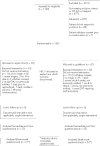A patient decision aid to support shared decision-making on anti-thrombotic treatment of patients with atrial fibrillation: randomised controlled trial
- PMID: 17545350
- PMCID: PMC2464985
- DOI: 10.1136/qshc.2006.018481
A patient decision aid to support shared decision-making on anti-thrombotic treatment of patients with atrial fibrillation: randomised controlled trial
Abstract
Objective: To determine the efficacy of a computerised decision aid in patients with atrial fibrillation making decisions on whether to take warfarin or aspirin therapy.
Design: Two-armed open exploratory randomised controlled trial.
Setting: Two research clinics deriving participants from general practices in Northeast England.
Participants: 109 patients with atrial fibrillation aged over 60.
Interventions: Computerised decision aid applied in shared decision-making clinic compared to evidence-based paper guidelines applied as direct advice.
Main outcome measures: Primary outcome measure was the decision conflict scale. Secondary outcome measures included anxiety, knowledge, decision-making preference, treatment decision, use of primary and secondary care services and health outcomes.
Results: Decision conflict was lower in the computerised decision aid group immediately after the clinic; mean difference -0.18 (95% CI -0.34 to -0.01). Participants in this group not already on warfarin were much less likely to start warfarin than those in the guidelines arm (4/16, 25% compared to the guidelines group 15/16, 93.8%, RR 0.27, 95% CI 0.11 to 0.63).
Conclusions: Decision conflict was lower immediately following the use of a computerised decision aid in a shared decision-making consultation than immediately following direct doctor-led advice based on paper guidelines. Furthermore, participants in the computerised decision aid group were significantly much less likely to start warfarin than those in the guidelines arm. The results show that such an approach has a positive impact on decision conflict comparable to other studies of decision aids, but also reduces the uptake of a clinically effective treatment that may have important implications for health outcomes.
Conflict of interest statement
Competing interests: None declared.
References
-
- Fairhurst K, May C. Consumerism and the consultation: the doctor's view. Family Practice 199512389–391. - PubMed
-
- Department of Health Better information, better choices, better health: Putting information at the centre of health. London: Department of Health, 2004
-
- Elwyn G, Edwards A.Evidence based patient choice. Oxford: Oxford University Press, 2001
-
- O'Connor A, Stacey D, Entwistle V.et al Decision aids for people facing health treatment or screening decisions. The Cochrane Library 20041
Publication types
MeSH terms
Substances
Associated data
Grants and funding
LinkOut - more resources
Full Text Sources
Medical




